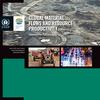Похожие презентации:
Solid waste biotreatment. Ethanol production from lignocellulosic materials. Lecture 5
1.
BIOPROCESS TECHNOLOGYDr. TERESA FERNANDEZ ALDAMA
“SAMARA UNIVERSITY”
1
2.
LECTURE No. 5. SOLID WASTEBIOTREATMENT. Ethanol production
from lignocellulosic materials (II)
2
3.
IntroductionStructure of lignocellulosic materials
Hydrolysis
Acidic
Enzymatic
Pretreatment
Formation of inhibitors
3
4.
ObjectivesTo identify the inhibitors formed during
pretreatment of lignocellulosic materials.
To describe the most important strategies to
overcome the inhibition problems.
To discuss the choice of microorganisms to be
used in the fermentation of lignocellulosic
hydrolysates.
4
5.
OutlineFormation of inhibitors
Strategies to overcome the inhibition problems
Preventing formation of inhibitors
Reduction of amounts of formed inhibitors
(Detoxification)
Adaptation of strains to inhibitors
Fermentation of lignocellulosic hydrolyzates
Lignocellulosic hydrolyzates
Microorganisms
5
6.
Formation of inhibitorsCellulose
Hemicellulose
Glucose Mannose Galactose
Hydroxymethyl furfural (HMF)
Xylose Arabinose
Lignin
Extractives
Phenols
Furfural
Acetic acid
Levulinic acid Formic acid
6
7.
Formation of inhibitorsCellulose
Hemicellulose
Glucose Mannose Galactose
Xylose Arabinose
Hydroxymethyl furfural (HMF)
Lignin
Extractives
Phenols
Furfural
Acetic acid
1. Furan aldehydes
Levulinic acid Formic acid
7
8.
Formation of inhibitorsCellulose
Hemicellulose
Glucose Mannose Galactose
Hydroxymethyl furfural (HMF)
Lignin
Xylose Arabinose
Extractives
Phenols
Furfural
Acetic acid
Levulinic acid Formic acid
2. Aliphatic acids
8
9.
Formation of inhibitorsCellulose
Hemicellulose
Glucose Mannose Galactose
Xylose Arabinose
Lignin
Extractives
Phenols
3. Phenolic compounds
Hydroxymethyl furfural (HMF)
Furfural
Acetic acid
Levulinic acid Formic acid
9
10.
Formation of inhibitorsHemicellulose
Cellulose
Glucose Mannose Galactose
Hydroxymethyl furfural (HMF)
Xylose
Lignin
Extractives
Phenols
Arabinose
Furfural
Acetic acid
Levulinic acid Formic acid
☹ Cell physiology (decrease viability)
☹ Low ethanol yield and productivity
10
11.
Flowchart for ethanol production from LCMLignocellulosic Materials
Pretreatment
Hydrolysis
Physical
Biological
Chemical
Physico-chemical
???
Fermentation
Distillation
Ethanol
11
12.
Strategies to overcome inhibition problems1. Preventing formation of inhibitors
To select less recalcitrant feedstock and to
utilize mild pretreatment conditions
Simultaneous saccharification and fermentation
(SSF)
12
13.
Simultaneous saccharification and fermentation (SSF)13
14.
Strategies to overcome inhibition problems2. Reduction of amounts of formed inhibitors (Detoxification)
Biological: involve the use of microorganism that
convert toxic compounds by changing their chemical
structure.
Physical: promote the removal of toxic compounds
from the medium without changing their chemical
structures.
Chemical: based on the use of chemical additives
(overliming, reducing agents, polymers) and pH
modifications.
14
15.
Strategies to overcome inhibition problems2. Reduction of amounts of formed inhibitors (Detoxification)
☺ Improve fermentability and
saccharification
of cellulose.
enzymatic
☹ A separate step is required.
15
16.
Strategies to overcome inhibition problems3. Adaptation of strains to inhibitors: ability of
microorganism
to
grow
in
lignocellulosic
hydrolysates.
☺ They can increase the tolerance to:
phenolic compounds,furaldehydes and aliphatic acids.
high temperature.
16
17.
Screening0%
25 %
50 %
75 %
100 %
Agar plates with
hydrolyzate
Liquid culture medium with
Hidrolyzates
Resistant
strain
50%
65%
80%
90%
95%
17
18.
Original strain30 oC
32 oC
34 oC
36 oC
38 oC
40 oC
Resistant strain
18
19.
Fermentation of lignocellulosic hydrolysates1. Particularities of LC hydrolysates
Low glucose concentration
High content of pentoses (xylose: ~33%
of the total sugar in bagasse)
Inhibitors
19
20.
2. Microorganisms used in ethanol production2.1. Essential requirements
High ethanol yield and productivity
Conversion of all the sugars
Low by-product formation
Ethanol tolerance
Tolerance to inhibitors
20
21.
2.2. Desirable requirements• Simultaneous consumption of different sugars
• Degradation of cellulose and hemicellulose
• GRAS status (General Regarded As Save)
• High cell size
• Ability to ferment at low pH
• Ability to ferment anaerobically
• Thermal tolerance
21
22.
2.3. The use of S cerevisiae in fermentation oflignocellulosic hydrolyzates
Manose
Galactose
Glucose
Xylose
Arabinose
Ethanol
Theoretical yield
0,51 g ethanol/g sugar
22
23.
2.4. Natural xylose-utilising microorganismsYeasts
Fungi
Pichia stipitis,
Pachysolen tannophilus,
Candida shehatae
Fusarium
☹ Controlled aeration is required,
sensible to inhibitors, xylitol
production
☹ Low productivity
Bacteria
Bacillus,
Clostridium,
Thermoanaerobacter
☹ Mixtures of acids, pHopt ~7,
pathogenicity
23
24.
2.5. Recombinant xylose-utilising S. cerevisiaeExpression of bacterial xyl A (XI) gene
Expression of yeast XYL1 (XR) and XYL2
(XDH) genes
Xylose
XI
Xylulose
Yeast
Ethanol
XDH
XR
Xylitol
XI: xylose isomerase
XR: xylose reductase
XDH: xylitol deshidrogenase
24
25.
2.5. Recombinant xylose-utilising S. cerevisiaeExpression of bacterial xyl A (XI) gene
Expression of yeast XYL1 (XR) and XYL2
(XDH) genes
Xylose
XI
Xylulose
Yeast
Ethanol
XDH
XR
Xylitol
XI: xylose isomerase
XR: xylose reductase
XDH: xylitol deshidrogenase
25
26.
2.5. Recombinant xylose-utilising S. cerevisiaeUtilize xylose
Produce ethanol
Ethanol tolerance
Inhibitors tolerance
26
27.
Ethanol production from LCMLignocellulosic
Materials
Ethanol
27
28.
Flowchart for ethanol production from LCMLignocellulosic Materials
Pretreatment
Hydrolysis
Detoxification
Fermentation
Distillation
Ethanol
28
29.
Whole cycle of ethanol productionSugar
cane
Rice
Peanut
Ethanol
H2SO4
Hydrolysis
Destillation
Sugar solution
Fermentation
29
30.
Control questions1. Describe inhibitory formation during pretreatment
and explain its effect in the fermentation process?
2. Describe some of strategies to overcome the
inhibition problem.
3. According to the composition of lignocellulosic
hydrolyzates, analyze the choice of the appropriate
microorganism.
30
31.
Suggested literature-
Harmsen P., Huijgen W., Bermudez L., Bakker R. Literature
review of physical and chemical pretreatment processes for
lignocellulosic biomass. Biosynergy, 2010, Report 1184. ISBN
978-90-8585-757-0.
-
Kim D. Physico-Chemical Conversion of Lignocellulose:
Inhibitor Effects and Detoxification Strategies: A Mini Review.
Molecules, 2018, 23, 309.
-
Mohammad J.T., Keikhosro K. Acid-based hydrolysis processes
for ethanol from lignocellulosic materials: A review.
BioResources, 2007, 2 (3), 472-499.
31
32.
THANK YOU FOR YOURATTENTION!
32
































 Химия
Химия Промышленность
Промышленность








